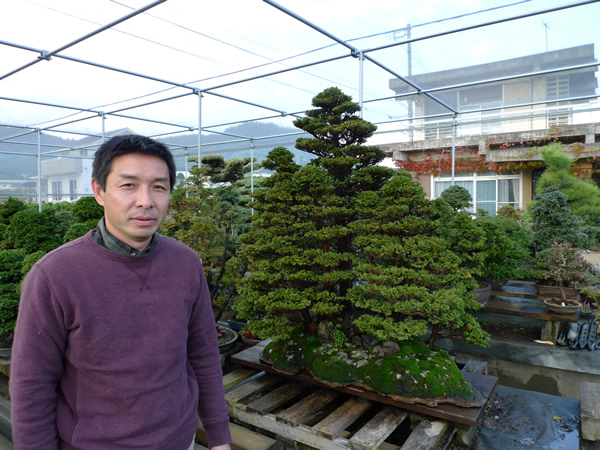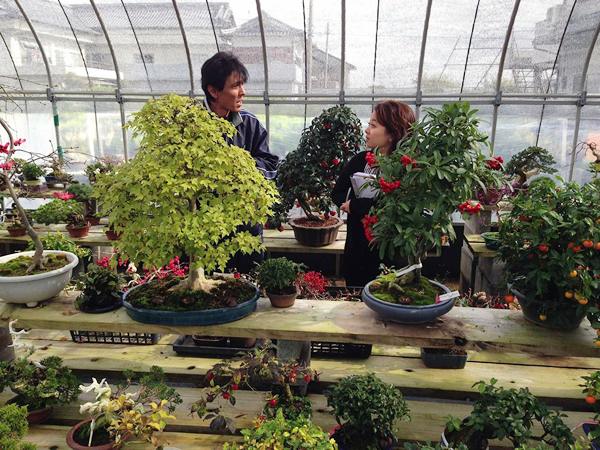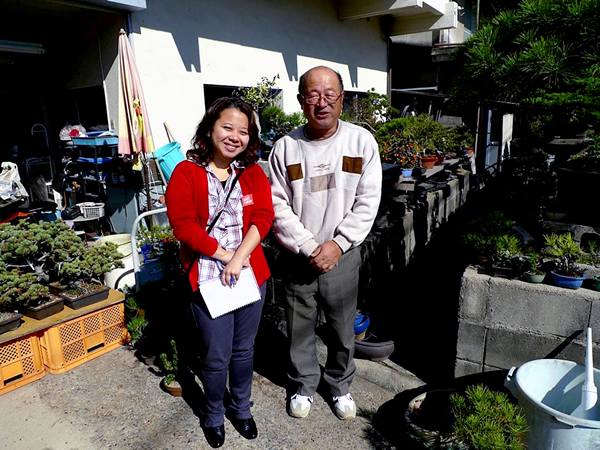Report of Bonsai Nursery
Bonsai exportation: a business which needs good relationship
Kinashi and Kokubunji in Takamatsu City, Kagawa prefecture are the biggest bonsai producing areas in Japan. For this reason, the sale and export of bonsai trees, principally for the United States and Korea have become important business in these areas. Matsuda Seishoen in Kinashi, which is managed by Mitsuo Matsuda’s family, has been in bonsai business for more than 60 years. In this garden, the main business is bonsai export, which started about 40 years ago with Mitsuo Matsuda’s father in a spontaneous way. “We had a bonsai boom among the Japanese and my father was selling trees only to Japanese customers. But, some years after this boom, Japanese customers were decreasing, but, on the other hand, Koreans and Taiwanese had become interested in bonsai and they came to our nursery to buy trees. So, we started exporting bonsai”, said Mitsuo Matsuda.
Last year, Matsuda Seishoen sent more than 20 thousand bonsai trees to foreign countries like Taiwan, Korea, the United States and Russia. But, the total figure of annual bonsai export depends on not only market needs but also the number of available trees, because bonsai needs a long period to grow big enough to be removed from the fields, potted and, with strong roots, shipped to other countries. To attend his customers’ requests, Mitsuo Matsuda buys trees produced in other gardens around Kinashi and Kokubunji areas.
Process

The process of bonsai export goes through several stages and it takes around two weeks that bonsai actually arrives at foreign nurseries. Mitsuo Matsuda makes each step carefully. First of all, the garden’s employees remove bonsai from the pot, and wash the soil away completely with strong water-jet. They need to be really careful in this step not to damage the roots. After this, they put the bonsai into a plastic bag. In this plastic bag, they put water to safeguard the tree and keep it alive. These steps take three or four days, depending on how many trees are exported.
After these preparations in the garden, bonsai trees are transported from Takamatsu to Osaka Airport by plane and, from Osaka Airport to their destinations. When the trees arrive in foreign countries, they need around one week for quarantine, and then finally will be shipped to importers’ nurseries.
Good relation
In anticipation of bonsai popularity fall, Mitsuo Matsuda has been making an effort to develop a good relationship with foreign customers. “We can’t keep the customers directly, but we are doing our best to keep connections with importers and their customers”, he said.
In the first place, he is careful with all the details of export process to ensure that it proceeds as he arranged. “Some people think that after trees leave Japan, they are not responsible for bonsai condition anymore. But, I think in a different way. For me, the process is done only when the bonsai arrives alive and safe at its new nursery”, he emphasized.
In addition to this unique way to treat his business, Mitsuo Matsuda has invested time and energy in studying about bonsai and travelling to the importers’ countries to teach bonsai techniques. “If the importers are not so familiar with bonsai techniques, I can go to their places and teach their employees and customers all the techniques. I think this good relation with the importers is the key of our business”, he said.
Mitsuo Matsuda has also participated in several bonsai exhibitions inside and outside Japan to further refine his techniques. He wants to be recognized not just as a bonsai producer, but also as a bonsai master too. “I want to keep exporting, but I know this kind of business is always changing. What will I do, produce bonsai or teach bonsai techniques for the entire world? I don’t know, but I appreciate the function of bonsai master, and I think, while exporting and teaching our importers and costumers, I’m making my own system and just trying to find a light for our business”, he said optimistically.
Shohin bonsai: big dedication for small trees
Cultivating bonsai is an art that needs dedication, technique and patience, regardless of the size of the tree. “Bonsai is like a child and we need to take care of it all the time”, said the bonsai master Koji Hiramatsu, who is born amid the black pines and has been the owner of Hiramatsu Shunshoen Bonsai Garden for 20 years. The fourth generation of his family working in this business, Koji Hiramatsu is proud to be recognized as an expert of shohin bonsai, which is less than 25 centimeters in height.
Koji Hiramatsu decided to study and learn production techniques about mini bonsai approximately 15 years ago, to meet the customers’ expectations. In those days, small trees were not common in Takamatsu, and he went to other regions in Japan such as Saitama and Nagoya to look for small ones. Today, his garden has more than 500 shohin bonsai, accounting for 30% of all the trees.

According to Koji Hiramatsu, the number of shohin bonsai lovers is increasing, mainly because people are attracted by its compact size. “Japanese bonsai customers are getting old and a small tree is easier to take care of. Besides, many young customers live in apartments and don’t have much space to have a normal size tree”, he explained.
Shohin bonsai can be produced with black pine, white pine, junipers and fruit trees, like cherry or apple, even though these trees are common for producing regular size bonsai. The fruit trees bonsai are popular among women, because of the flowers and fruits color.
In case of growing bonsai smaller, the care needs to be adjusted properly. The most important one is water quantity, especially in summer when the bonsai is watered three times a day. “We have to water trees correctly, because too much water gets the soil drenched, but too little hinders the growth”, said Koji Hiramatsu. The irrigation is so important that new employees in his garden receive a three years training to be a master in watering.
For this reason, Koji Hiramatsu recommends the Japanese black pine to bonsai beginners. “As for watering, this tree is really drought-tolerant and perfect for those who don’t have much experience. Furthermore, the black pine is known as the king of bonsai because of its beauty, and this is another good reason to choose this species”, he said.
Price
Pricing bonsai trees which need so much dedication is not so easy. Although there is a kind of common market value, price depends on two factors: tree’s shape and age. The age of bonsai tree can reach 300 years. In other words, more differentiated and older the tree is, higher will be its price. To create the ideal shape, bonsai trees in Hiramatsu’s garden are wired. This involves attaching wires to the trunk and branches to make a desired curve or correct an unwanted curve. “Our Japanese soul is sensitive and we are constantly looking for wabi-sabi, which is traditional Japanese ideals of beauty and perfection, to develop the perfect shape”, said Koji Hiramatsu.
If the tree has a beautiful shape and it is very old, the price will be very high, regardless of the size. In Hiramatsu’s garden, for example, a black pine, which is approximately 40 centimeters high costs two millions yen and a 60 years old juniper, which was less than 20 centimeters tall was sold for three millions yen last year.
Change of seasons: time to be more careful in watering
The most important care of bonsai is watering in the correct way, depending on each season. For example, in the summer, when the temperature in Takamatsu rises around 35°C, the trees need water twice or three times in a day to cold themselves. But, the decline of temperature as the season turns into autumn doesn’t mean bonsai doesn’t need water. On the contrary, especially the pines need water every day, because autumn is the season to mature for this species. Moreover, in autumn are held the important bonsai exhibitions throughout Japan and watering is essential to keep trees healthy for these events.

Hiroyoshi Yamaji, the second owner of Yamaji Sanshoen in Kokubunji knows considerably how important watering is for bonsai. In his garden, watering is the essential work. “More than work, watering is a duty to make the bonsai happy”, he said. In order to water the trees properly, he looks at the surface of the soil in the pots. “When the soil is so white, it means it’s dried. So, in the moment we water them, the soil absorbs water and will turn into dark color”, he explained.
Other important aspect of watering trees is to understand that each bonsai has different metabolism and the amount of water needed differs from each other. Hiroyoshi Yamaji compares bonsai to human children. “Bonsai trees have different needs and the younger ones catch more water than the older ones. Human children eat a lot because they need energy to grow and the same thing happens with young bonsai”, he said.
Information & Map
| Matsuda Seishoen bonsai garden | Address: 166-2 Sato, Kinashi-cho, Takamatsu, Kagawa Prefecture, Japan TEL: 087-881-2947 (from Japan outside Takamatsu) 81-87-881-2947 (from outside Japan) |
|---|---|
| Hiramatsu Shushoen bonsai garden | Address: 2365-2 Nii, Kokubunji-cho, Takamatsu, Kagawa Prefecture, Japan TEL: 087-874-0335 (calls from Japan outside Takamatsu) 81-87-874-0335 (calls from outside Japan) All-Japan Shohin-Bonsai Association Kagawa Kokufu branch office |
| Yamaji Sanshoen bonsai garden | Address: 3425-1 Nii, Kokubunji-cho, Takamatsu, Kagawa Prefecture, Japan TEL: 087-874-1378 (calls from Japan outside Takamatsu) 81-874-1378 (calls from outside Japan) |
Reporter profile
Gisele Hiromi Nogami, 25 years old. I’m living in Belém, a state in the North side of Brazil. I graduated in Publicity and Journalism in the Amazon University – Universidade da Amazônia. In my family, I’m the third generation born in Brazil. My grandparents from my father’s side, were born in Kagawa-ken. In Brazil, I worked at a local newspaper called O Liberal.